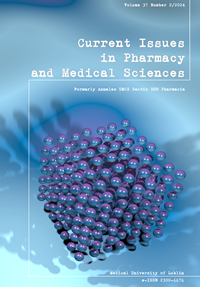Formulation and development of Tacrolimus nanosponges-loaded hydrogel for the treatment of atopic dermatitis
DOI:
https://doi.org/10.2478/cipms-2024-0016Keywords:
nanosponges, tacrolimus, hydrogel, cyclodextrin, drug deliveryAbstract
Targeted drug delivery to specific locations is a significant challenge encountered by researchers. Nanosponges have emerged as a promising solution for delivering drugs to their target sites. Nanosponges are nanoparticles with a large surface area, allowing for enhanced penetration compared to conventional drug delivery systems. This new technology offers controlled drug release and has several advantages over other methods. This project aimed to prepare and evaluate a Tacrolimus-loaded Nanosponges hydrogel. The goal was to create a dermatological gel suitable for local drug delivery after topical application, aiming for improved therapeutic effects, better dispersibility and good storage stability. Tacrolimus-loaded Nanosponge was prepared using beta-cyclodextrin and ethylcellulose as polymers, along with polyvinyl alcohol (PVA) as a surfactant. The solvent emulsion diffusion technique is a method for preparing nanosponges, and the variations in the formulation using different polymers and drug-polymer ratios offer the opportunity to fine-tune the nanosponge's properties to meet specific requirements for drug delivery applications. A Tacrolimus-loaded nanosponge hydrogel was formulated using carbopol 934. The results of the study indicated that the optimized batch of nanosponges with high entrapment efficiency was chosen for formulating the gel incorporating carbopol 934. The gel that was prepared was subjected to assessments for pH, viscosity, spreadability, in-vitro diffusion, permeation and stability. The findings suggest that Tacrolimus can be effectively formulated in low doses of nanosponges-loaded hydrogel for atopic dermatitis.
References
1. Langer R. Transdermal drug delivery: past progress, current status, and future prospects.Adv Drug Deliv Rev. 2004;5:557-8.
2. Vyas SP, Khar RK.Targeted and controlled drug delivery novel carrier systems: molecular basis of targeted drug delivery.New Delhi: CBS Publishers and Distributors; 2012.
3. Shoughy SS.Topical tacrolimus in anterior segment inflammatory disorders.Eye Vis (Lond). 2017;4:7.
4. Malecic N, Young H. Tacrolimus for the management of psoriasis: clinical utility and place in therapy. Psoriasis:Targ Ther.2016;6: 153-63.
5. Ohtsuki M, Morimoto H, Nakagawa H. Tacrolimus ointment for the treatment of adult and pediatric atopic dermatitis: Review on safety and benefits.J Dermatol.2018;24(8):936-42.
6. Chamkouri H. A Review of hydrogels, their properties and applications in medicine.Am J Biomed Sci Res.2021;11:485-93.
7. Gaikwad DS, Chougale RD, Patil KS. Design, development, and evaluation of docetaxel-loaded niosomes for the treatment of breast cancer.Futur J Pharm Sci.2023;9:43.
8. Ajala TO, Omoteso OA, Awe OM. The design and evaluation of ciprofloxacin-loaded nanoformulations using Ipomoea batatas starch nanoparticles.Futur J Pharm Sci. 2023;9:37.
9. Brewster ME, Loftsson T. Cyclodextrins as pharmaceutical solubilizers.Adv Drug Deliv Rev.2023;59(7):645-66.
10. Santos DI, Neiva Correia MJ, Mateus MM, Saraiva JA, Vicente AA, Moldão M. Fourier Transform Infrared (FT-IR) spectroscopy as a possible rapid tool to evaluate abiotic stress effects on pineapple by-products.Appl Sci.2019;9:4141.
11. Khan MA, Rehman A, Howari H, Alhodaib A, Ullah F, Mustafa ZU, Elaissari A, Ahmed N. Hydrogel containing solid lipid nanoparticles loaded with argan oil and simvastatin: Preparation,In vitroandex vivoassessment.Gels. 2022;11(5):277.
12. Pawar A, Rao J, Tapkir A, Malpure P, Bachhav R. Development and characterization of griseofulvin nanosponges to enhance bioavailability: Pharmaceutical science-pharmaceutics.Int J Life Sci.2022:99-111.
13. Baboota S, Shakeel F, Ahuja A, Ali J, Shafiq S. Design, development and evaluation of novel nanoemulsion formulations for transdermal potential of celecoxib. Acta Pharm. 2007;57(3):315-32.
14. Ohtsuki M, Morimoto H, Nakagawa H. Tacrolimus ointment for the treatment of adult and pediatric atopic dermatitis: Review on safety and benefits.J Dermatol.2018;8:936-42.
15. Shankar G, Agarwal YK. Formulation and Evaluation – cyclodextrin Nanosponges of a poorly water-soluble drug.J Chem Pharm Res.2015;7(4):595-604.
16. Dheer D, Jyoti Gupta PN, Shankar R. Tacrolimus: An updated review on delivering strategies for multifarious diseases.Eur J Pharm Sci.2018;114:217-27.
17. Tanwar YS, Jain AK. Formulation and evaluation of topical diclofenac sodium gel using different gelling agents.Asian J. Pharm.2012;4:1-6.
18. Gangadharappa HV, Chandra Prasad SM, Singh RP. Formulation in vitro and In vivo evaluation of celecoxib nanosponge hydrogels for topical application.J Drug Deliv Sci Technol.2017;41:488-501.
19. Nagavarma Namburi BV, Hemant KS, Yadav HS, Ayaz A, Vasudha LS, Shivakumar HG. Formulation and evaluation of polymeric nanoparticulate gel for topical delivery.Asian J Pharm Clin Res.2012;5(3):16-23.
20. Simonsen L, Fullerton A. Development of an in vitro skin permeation model simulating atopic dermatitis skin for the evaluation of dermatological products.Skin Pharmacol Physiol. 2007;20(5):230-6.
Downloads
Published
Issue
Section
License
Copyright (c) 2024 Authors

This work is licensed under a Creative Commons Attribution-NonCommercial-NoDerivatives 3.0 Unported License.


